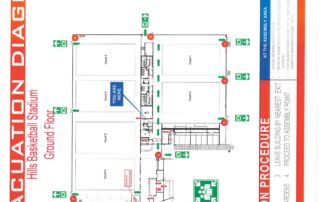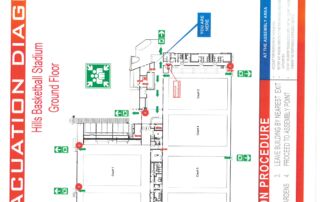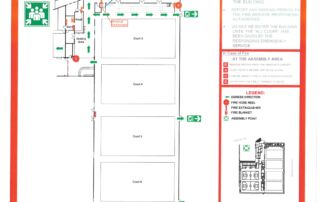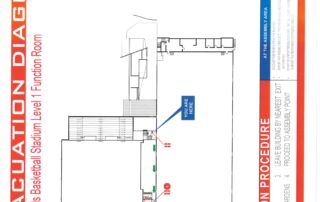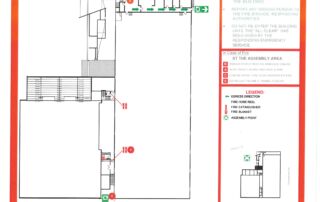EMERGENCY
HILLS BASKETBALL ASSOCIATION STAFF PORTAL
Click on YouTube link for a quick overview.
Venue Emergency Evacuation Plans
Click here to view full HBA Emergency Policy.
The role of Staff in an Emergency Evacuation
- Begin and control safe evacuation
- Ensure people remain clear of danger
- Report missing people to Emergency Services
- Give technical advice and help to Emergency Services
Before an Emergency Occurs
- Familiarise yourself with the emergency procedures
- Participate in training
- Maintain emergency equipment
- Know the evacuation routes for the Stadium and where to assemble patrons and staff
- Know where emergency equipment is kept.
- Know how to report emergencies and operate alarms or communications equipment
- Know if anyone needs special help to evacuate
Quick Reference Guides
FIRE AND EVACUATION
- Alert and assemble other staff on duty.
- Identify location of fire.
- Contact Fire Brigade (000).
- Alert Fire Brigade of chemicals on premises.
- Evacuate area and assemble patrons in ‘Safe Areas’.
- Contain fire / smoke by closing doors and windows (do not lock) if safe to do so.
- Extinguish the fire if safe to do so.
- Provide first aid if required.
- When evacuation completed account for all staff and patrons (if possible).
ALL CLEAR GIVEN BY AUTHORITIES:
- Assess damage to Stadium, clean up area and ensure all equipment, structures etc are safe.
- Re-establish operations if possible.
- Send injured staff to hospital for check up.
- Write report on incident (with witness reports).
- Debrief employees.
OPERATIONAL MISHAP
- Secure and make safe the mishap area .
- Ensure appropriate first aid is tendered.
- Investigate the mishap immediately.
- Contact the Stadium and/or the Game/Stadium Supervisor.
- Complete details in the Communication Logbook immediately.
- Fill in ‘Injury Incident Report’ if accident happened to employee.
- All injured employees must see a Doctor.
- Where appropriate, clearance will be required by Workcover NSW and OH&S section before commencement of operations or use of equipment.
PERSONAL THREAT
(Armed Hold Up/Assault)
Prevention/Awareness
- The less temptation we offer the potential offender, the less chance we have of becoming a victim.
- Keep all cash and cash handling out of the view of the public.
- Keep cash levels at a minimum and advertise that there is little or no opportunity.
- When banking or transporting cash, vary the routine.
- Report all suspicious characters and behaviour and any unusual change in systems or routines to the Chief Executive Officer and /or the Police.
- Trust your first instincts.
- Never discuss the Stadium’s security or financial affairs outside of work- criminals are constantly looking for opportunities. What you say may be overheard or inadvertently passed on to the wrong people.
- All cash is to be kept in the stadium safe over night.
During an Armed Hold Up/Assault
- Don’t be a hero. Never challenge the offender physically or verbally.
- Remind yourself to remain calm mentally and remain calm and deliberate physically.
- Allow yourself time to check and listen carefully.
- Follow instructions. If you cannot comply explain why with the offender.
- Keep your hands in clear view and where possible, above shoulder height.
- Do not speak unless you are required to and avoid eye contact.
- If you stand side on to the offender, you are less of a threat.
- Do not trigger alarms, silent or otherwise, until the offender has left the premises.
- If you need to lower your hands or reach for anything to comply, explain why. Ask and wait for approval.
- Observe and collate. Look for height references, fixed objects on other people.
- Try to collate an accurate description of the weapon and always assume the weapon is real.
- The more details that you can give to the police, the greater the chance of apprehension.
- Make a list of details.
- Small details can be important. Concentrating on those details can help you remain calm.
- Avoid eye contact. Don’t make it obvious to the offender that you are observing them.
After the Incident
1. When sure the offenders have left the premises, contact the police.
2. Tell the police the following:
a. The time of the crime.
b. The exact location.
c. Injuries, if any.
d. How long since the crime was committed.
e. The known number of offenders.
f. The weapons used.
- Secure the scene. All entry and exit points should be locked to prevent access to the scene.
- If necessary, delegate staff members to guard and protect the scene from the public access to disturbance.
- Any witnesses to the incident should remain until the police arrive.
- Do not disturb the crime scene in any way. All items left or handled by the offenders should remain untouched.
- If possible, have all witnesses write down details such as descriptions of the offender and other details whilst waiting for the arrival of the police.
- Details pertaining to security and the amount of money involved should only be discussed with the police only.
Should a situation such as the one discussed ever occur, counseling will be provided for staff members who are the victims of the crime.
BOMB THREAT
- Handling Procedures
- In the case where a threat is received by telephone or by any other means:
- Staff on reception to ring the Police Department immediately
- Contact other staff in the centre
- Contact the Chief Executive Officer
- Secure all monies in safe
- In the case where a threat is received by telephone or by any other means:
- Evacuating Bomb Threat
- Check exits, designated compound areas and car park to verify they are safe
- Evacuation
- Discuss and nominate which exits are to be used for the evacuation (nominated standard exits may be appropriate)
- Second staff member to stand at entrance to prevent any person from entering or approaching the building.
- Commence evacuation procedures. All doors to remain open.
- Gather all people into disabled carpark area.
- Check change rooms for stragglers, also around grounds.
- Staff to remain with patrons and reassure them until emergency services have accessed area and given the ‘OK’ to return.
- Once centre is back in operation, write a report of incident, ring Chief Executive Officer and inform that all is OK.
BLACKOUT PROCEDURES
- Continue to communicate with patrons
- Explain to patrons what is happening. If power is not immediately restored escort patrons to the foyer area
- Conduct another check of the area ensuring all patrons are in the foyer.
- Call General Manager and explain situation.
- Lock gates and post signs explaining the situation.
- Call security and explain situation as alarm may not activate.



